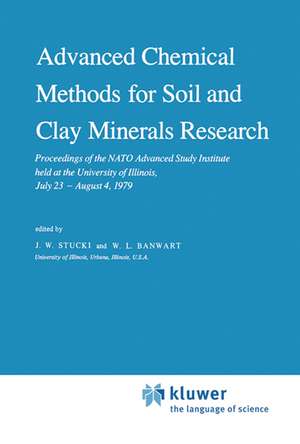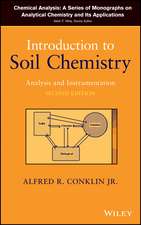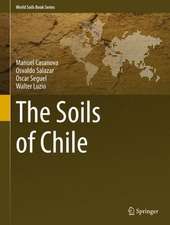Advanced Chemical Methods for Soil and Clay Minerals Research: Proceedings of the NATO Advanced Study Institute held at the University of Illinois, July 23 – August 4, 1979: Nato Science Series C:, cartea 63
Editat de J.W. Stucki, W.L. Banwarten Limba Engleză Hardback – 30 noi 1980
| Toate formatele și edițiile | Preț | Express |
|---|---|---|
| Paperback (1) | 1225.94 lei 6-8 săpt. | |
| SPRINGER NETHERLANDS – 13 oct 2011 | 1225.94 lei 6-8 săpt. | |
| Hardback (1) | 1232.26 lei 6-8 săpt. | |
| SPRINGER NETHERLANDS – 30 noi 1980 | 1232.26 lei 6-8 săpt. |
Din seria Nato Science Series C:
- 24%
 Preț: 797.69 lei
Preț: 797.69 lei - 18%
 Preț: 957.62 lei
Preț: 957.62 lei - 18%
 Preț: 957.13 lei
Preț: 957.13 lei - 18%
 Preț: 1227.52 lei
Preț: 1227.52 lei -
 Preț: 396.40 lei
Preț: 396.40 lei -
 Preț: 403.75 lei
Preț: 403.75 lei - 18%
 Preț: 1239.37 lei
Preț: 1239.37 lei - 18%
 Preț: 1236.51 lei
Preț: 1236.51 lei - 18%
 Preț: 1231.78 lei
Preț: 1231.78 lei - 18%
 Preț: 1229.10 lei
Preț: 1229.10 lei - 18%
 Preț: 1835.21 lei
Preț: 1835.21 lei - 24%
 Preț: 1076.39 lei
Preț: 1076.39 lei -
 Preț: 390.46 lei
Preț: 390.46 lei -
 Preț: 369.63 lei
Preț: 369.63 lei - 18%
 Preț: 1232.41 lei
Preț: 1232.41 lei -
 Preț: 394.51 lei
Preț: 394.51 lei - 18%
 Preț: 1226.24 lei
Preț: 1226.24 lei - 18%
 Preț: 1845.80 lei
Preț: 1845.80 lei -
 Preț: 399.88 lei
Preț: 399.88 lei -
 Preț: 384.28 lei
Preț: 384.28 lei -
 Preț: 390.88 lei
Preț: 390.88 lei -
 Preț: 381.19 lei
Preț: 381.19 lei - 18%
 Preț: 1848.64 lei
Preț: 1848.64 lei - 18%
 Preț: 951.14 lei
Preț: 951.14 lei - 18%
 Preț: 1230.35 lei
Preț: 1230.35 lei - 18%
 Preț: 1236.51 lei
Preț: 1236.51 lei -
 Preț: 401.03 lei
Preț: 401.03 lei -
 Preț: 406.25 lei
Preț: 406.25 lei - 18%
 Preț: 1230.84 lei
Preț: 1230.84 lei -
 Preț: 418.34 lei
Preț: 418.34 lei - 18%
 Preț: 1223.74 lei
Preț: 1223.74 lei
Preț: 1232.26 lei
Preț vechi: 1502.76 lei
-18% Nou
Puncte Express: 1848
Preț estimativ în valută:
235.80€ • 252.14$ • 196.60£
235.80€ • 252.14$ • 196.60£
Carte tipărită la comandă
Livrare economică 18 aprilie-02 mai
Preluare comenzi: 021 569.72.76
Specificații
ISBN-13: 9789027711588
ISBN-10: 9027711585
Pagini: 492
Ilustrații: X, 477 p.
Dimensiuni: 155 x 235 x 32 mm
Greutate: 0.86 kg
Ediția:1980
Editura: SPRINGER NETHERLANDS
Colecția Springer
Seria Nato Science Series C:
Locul publicării:Dordrecht, Netherlands
ISBN-10: 9027711585
Pagini: 492
Ilustrații: X, 477 p.
Dimensiuni: 155 x 235 x 32 mm
Greutate: 0.86 kg
Ediția:1980
Editura: SPRINGER NETHERLANDS
Colecția Springer
Seria Nato Science Series C:
Locul publicării:Dordrecht, Netherlands
Public țintă
ResearchCuprins
1. Mössbauer Spectroscopy.- 1-1. Introduction to the Mössbauer Effect.- 1-2. Basic Principles of Mössbauer Spectroscopy.- 1-3. Instrumentation and Experimental Procedures.- 1-4. Application of Mössbauer Spectroscopy to the Study of Silicate Minerals.- 1-5. The Study of Mineral Alteration Reactions.- 1-6. Iron Oxides and their Characterization in Soils.- 1-7. Critical Assessment of the Potential of Mössbauer Spectroscopy, and its Application to Nuclei Other than Iron.- References.- 2. Neutron Scattering Methods of Investigating Clay Systems.- 2-1. Introduction.- 2-2. Elementary Neutron Scattering Theory.- 2-3. Neutron Scattering Instrumentation and Methods.- 2-4. Applications of Neutron Spectroscopy to Studies of Clay Minerals.- Appendix 2-1. Macroscopic Cross Section for a Montmorillonite-Water System.- Appendix 2-2. Calculation of Incoherent Scattering Intensity Ratios for a Clay-Water System.- References.- 3. Introduction to X-ray Photoelectron Spectroscopy.- 3-1. Introduction.- 3-2. Trend of XPS Spectra.- 3-3. Instrumentation.- 3-4. Peak Position.- 3-5. Explored Depth.- 3-6. Peak Intensity.- 3-7. Overview of Methods of Characterization of Solids Based on X-ray, Electron and Ion Beams.- References.- 4. Application of X-ray Photoelectron Spectroscopy to the Study of Mineral Surface Chemistry.- 4-1. Uniqueness of XPS for the Investigation of Mineral Surface Phenomena — Probing Depth.- 4-2. Sample Handling Techniques.- 4-3. Analytical Applications.- 4-4. Electron Take-Off (Grazing) Angle Analysis Applications.- 4-5. Qualitative Bonding Investigations.- 4-6. Summary.- References.- 5. The Application of NMR to the Study of Clay Minerals.- 5-1. Introduction: Fundamentals of NMR.- 5-2. The Bloch Equations.- 5-3. Line Shape.- 5-4. Relaxation Mechanisms.- 5-5. Review ofSome Problems: Order and Disorder in Adsorbed Water Molecules.- References.- 6. Distribution of Ions in the Octahedral Sheet of Micas.- 6-1. Introduction.- 6-2. Influence of the Fe2+ Ions.- 6-3. H+ Spectra of Phlogopites.- 6-4. H+ Spectra of Biotites.- 6-5. F? Spectra.- 6-6. Correlation with I.R. Results.- References.- 7. General Theory and Experimental Aspects of Electron Spin Resonance.- 7-1. Introduction.- 7-2. G-Factor Tensor.- 7-3. Hyperfine Interaction.- 7-4. Analysis of ESR Spectra.- 7-5. Fine Structure.- 7-6. Summary.- Appendix 7-1.- Appendix 7-2.- Appendix 7-3.- References.- 8. Applications of ESR Spectroscopy to Inorganic-Clay Systems.- 8-1. Introduction.- 8-2. Surface-Bound Metal Ions.- 8- 3. Framework Paramagnetic Centers.- References.- 9. Application of Spin Probes to ESR Studies of Organic-Clay Systems.- 9- 1. Nitroxide Spin Probes — Origin of the ESR Spectrum.- 9-2. Nitroxides in Low-Viscosity Media — Rapid Isotropic Motion.- 9-3. Nitroxides in High-Viscosity Media.- 9-4. Nitroxides Adsorbed on Clay Surfaces.- 9-5. Experimental Considerations in Using Nitroxide Spin Probes.- References.- 10. Applications of Photoacoustic Spectroscopy to the Study of Soils and Clay Minerals.- 10-1. Introduction.- 10-2. Instrumentation.- 10-3. Results.- 10-4. Conclusions.- References.








